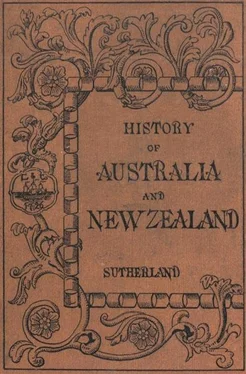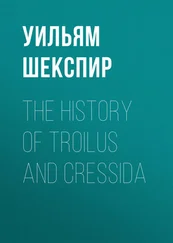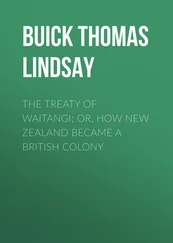CHAPTER XXIV.
NEW ZEALAND COLONISED.
1. Kororarika.—All this fighting of the Maori tribes made them more dependent on the trade they had with white men. They could neither make guns nor powder for themselves, and the tribe that could purchase none of the white man’s weapons was sure to be slaughtered and eaten by other tribes. Hence white men were more eagerly welcomed, and in course of time nearly two hundred of them were living Maori fashion with the tribes. But it was at the Bay of Islands that the chief trading was carried on. For it was there that the kauri timber grew; it was there that the pigs were most plentiful and the cargoes of flax most easily obtained; and when a man named Turner set up a grog-shop on the shores of the bay all the whaling ships made this their usual place for resting and refitting. Behind the beach the hills rise steeply, and on these hills a number of white men built themselves homes securely fenced, and defended, sometimes even by a cannon or two. But down on the little green flat next to the beach, rude houses were more numerous. In the year 1838 there were about 500 persons resident in the little town, which was now called Kororarika, but at times there were nearly double that number of people resident in it for months together. A wild and reckless place it was, for sailors reckoned themselves there to be beyond the reach of English law.
At one time as many as thirty-six ships lay off the town of Kororarika, and in a single year 150 ships visited the bay; generally staying a month or more at anchor. The little church and the Catholic mission station up on the hill did less good to the natives than these rough sailors did harm, and at length the more respectable white men could stand the disorder no longer. They formed an association to maintain decency. They seized, tried, fined or sometimes locked up for a time the worst offenders, and twice they stripped the ruffians naked, gave them a coat of tar, stuck them all over with white down from a native plant, and when they were thus decorated, expelled them from the town, with a promise of the same treatment if ever they were seen back in it.
2. Hokianga.—Long before this the capacities of New Zealand and the chances of making wealth there became well known in England, and in 1825 an association was formed to colonise the country. It sent out an agent, who reported that Hokianga, a deep estuary on the west coast, just opposite to Kororarika, and only thirty miles away from it, was a charming place for a settlement. The agent bought a square mile of land from the Maoris and also two little islands in the harbour. The company fitted out a ship the Rosanna , and sixty colonists sailed out in her to form the pioneers of the new colony. They landed, and liked the look of the place, but they were timid by reason of the tales they had heard of Maori ferocity. Now at this time the Ngapuhis were at war with the Arawas, and the latter were getting up a war dance, which the settlers were just in time to see. Five or six hundred men stood in four long rows, stamping in time to a chant of their leader. It was night, a fire lit up their quivering limbs and their rolling eyes; they joined in a chorus, and when they came to particular words they hissed like a thousand serpents; they went through the performance of killing their enemies, cutting up their bodies and eating them. The settlers fell into deep meditation and departed. Not half a dozen remained in New Zealand, the others went to Sydney, and so after an expense of £20,000 this association, which had been formed for the kindly purpose of putting people in lands less crowded than their own, failed and was disbanded.
3. Settled Government.—Between 1825 and 1835 the Maoris of the North Island were in a miserable state. Wars and massacres and cannibal feasts made the country wretched, and though the missionaries were respected they could not secure peace. But they persuaded the chiefs of some of the weaker tribes to appeal to England for protection against the conquering warriors who oppressed and destroyed their people. It was in 1831 that this petition was sent to King William, and about the same time the white men at Kororarika, terrified at the violence with which the Waikato men were ravaging the surrounding lands, asked the Governor at Sydney to interfere. The result was that although the English would not regularly take possession of New Zealand, they chose Mr. Busby, a gentleman well known in New South Wales, to be the Resident there, his business being, so far as possible, to keep order. How he was to keep order without men or force to make his commands obeyed it is hard to see; but he was expected to do whatever could be done by persuasion, and to send for a British war-ship if ever he thought it was needed.
The first war-ship that thus came over did more harm than good. Its visit was caused by a disastrous wreck. The whaling barque Harriet , under the command of a man named Guard, a low fellow who had formerly been a convict, was trading among the islands when she was wrecked off the coast of Taranaki. The Maoris attacked the stranded ship, but the crew stayed on her and fired into the assailants, and it was not till after quite a siege, in which twelve seamen were killed, that the rest fled from the wreck, leaving Mrs. Guard and her two children in the hands of the Taranaki tribe. Guard and twelve seamen, however, though they escaped for a time were caught by a neighbouring tribe, to whom he promised a cask of gunpowder if they would help him to reach an English ship. This they did, and Guard reached Sydney, where he begged Sir Richard Bourke to send a vessel for the rescue of his wife and children. Bourke sent the Alligator , with a company of soldiers, who landed and demanded the captive seamen. These were given up, but the captain of the ship supported Guard in breaking his promise and refusing to give the powder, under the plea that it was a bad thing for natives. The Alligator then went round to Taranaki for the woman and children. The chief of the tribe came down to the beach and said they would be given up for a ransom. The white men seized him, dragged him into their boat to be a hostage, but he jumped out of the boat and was speared with bayonets. He was taken to the ship nearly dead. Then the natives gave up the woman and one child in return for their chief. After some parley a native came down to the beach with the other child on his shoulders. He said he would give it up if a proper ransom was paid. The English said they would give no ransom, and when the man turned to go away again, they shot him through the back, quite dead. The child was recovered, but Mrs. Guard and the children testified that this native had been a good friend to them when in captivity. Nevertheless, his head was cut off and tumbled about on the beach. The Alligator then bombarded the native pah, destroyed all its houses to the number of 200, with all the provisions they contained, killing from twenty to thirty men in the process. This scarcely agreed with the letter which Mr. Busby had just received, in which he was directed to express to the Maori chiefs the regret which the King of England felt at the injuries committed by white men against Maoris.
4. Captain Hobson.—But there were many difficulties in securing justice between fickle savages and white men who were in general so ruffianly as those who then dwelt in New Zealand. The atrocities of the Harriet episode did some good, however, for along with other circumstances they stirred up the English Government to make some inquiries into the manner in which Englishmen treated the natives of uncivilised countries. These inquiries showed much injustice and sometimes wanton cruelty, and when a petition came from the respectable people of Kororarika, asking that some check should be put upon the licence of the low white men who frequented that port, the English Government resolved to annex New Zealand if the Maoris were willing to be received into the British Empire. For that purpose they chose Captain Hobson, a worthy and upright sea-captain, who in his ship of war, the Rattlesnake , had seen much of Australia and New Zealand. It was he who had taken Sir Richard Bourke to Port Phillip in 1837, and Hobson’s Bay was named in his honour. After that he had been sent by Bourke to the Bay of Islands to inquire into the condition of things there, and when he had gone home to England he had given evidence as to the disorder which prevailed in New Zealand. He was sent in a war-ship, the Druid , with instructions to keep the white men in order, and to ask the natives if they would like to become subjects of Queen Victoria and live under her protection. If they agreed to do so, he was to form New Zealand into an English colony and he was to be its Lieutenant-Governor under the general control of the Governor of New South Wales.
Читать дальше












